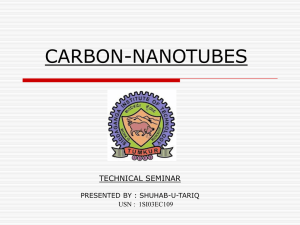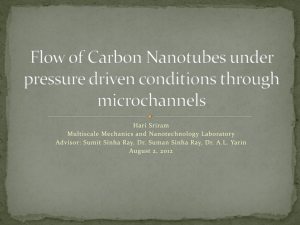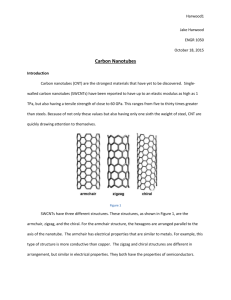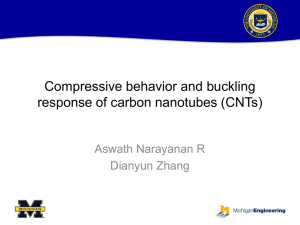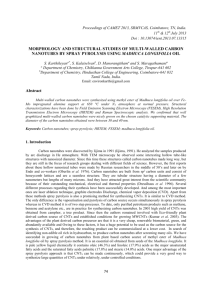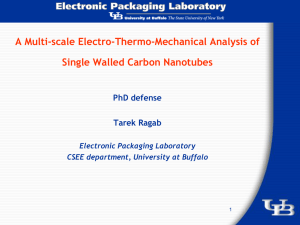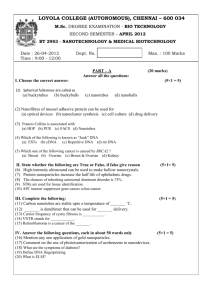masud-anshu draft dnrev
advertisement
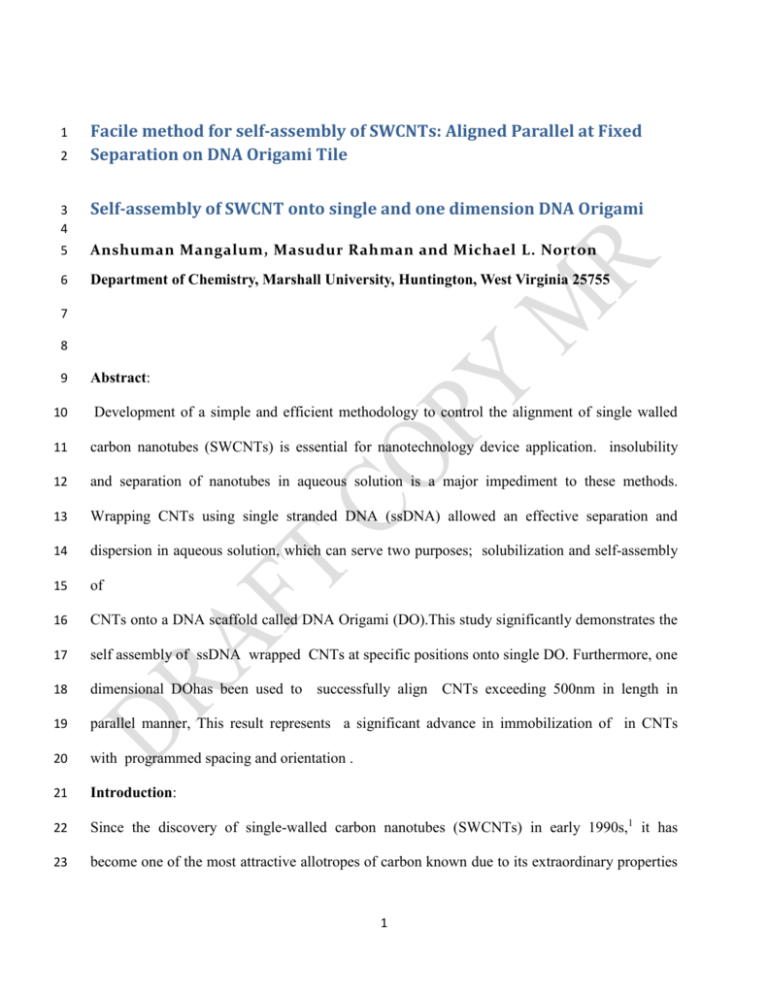
1 2 Facile method for self-assembly of SWCNTs: Aligned Parallel at Fixed Separation on DNA Origami Tile 3 4 Self-assembly of SWCNT onto single and one dimension DNA Origami 5 Anshuman Mangalum, Masudur Rahman and Michael L. Norton 6 Department of Chemistry, Marshall University, Huntington, West Virginia 25755 7 8 9 Abstract: 10 Development of a simple and efficient methodology to control the alignment of single walled 11 carbon nanotubes (SWCNTs) is essential for nanotechnology device application. insolubility 12 and separation of nanotubes in aqueous solution is a major impediment to these methods. 13 Wrapping CNTs using single stranded DNA (ssDNA) allowed an effective separation and 14 dispersion in aqueous solution, which can serve two purposes; solubilization and self-assembly 15 of 16 CNTs onto a DNA scaffold called DNA Origami (DO).This study significantly demonstrates the 17 self assembly of ssDNA wrapped CNTs at specific positions onto single DO. Furthermore, one 18 dimensional DOhas been used to successfully align CNTs exceeding 500nm in length in 19 parallel manner, This result represents a significant advance in immobilization of in CNTs 20 with programmed spacing and orientation . 21 Introduction: 22 Since the discovery of single-walled carbon nanotubes (SWCNTs) in early 1990s,1 it has 23 become one of the most attractive allotropes of carbon known due to its extraordinary properties 1 24 such as light weight (do you mean low density?) , high tensile strength and unique thermal, 25 electrical and optical properties.2 SWCNT are essentially ,graphene sheets rolled-up into a 26 hollow cylindrical shape and are particularly remarkable for the tunablility of their physical 27 properties based on the type of tube that is formed. Notable is the potential for very high aspect 28 ratio, achievable with nanometer sized diameter and lengths as long as 18.5cmcan be 29 growndepending the synthetic protocol.3 Based on helicity and diameter, CNTs can be 30 semiconductor or metallic and these two varieties are preferred for separate applications.4 31 Semiconductor CNTs are used for charge transfer methods such as components in sensors, solar 32 cells, and field emission displays, metallic CNTs can also be used in electronic devices as well 33 as fillers in CNT-composite materials.5 The solubility of CNTs in common solvents and the 34 clustering and formation of aggregates 35 harnessing CNTs properties to the fullest. The aggregation of unmodified CNTs leads to changes 36 the optical and electronic properties and hence impedes practical applications.6 Concurrent with 37 these challenges and advancements in CNT chemistry, DNA based nanotechnology has been 38 gaining importance due to its wide range of applications in different fields of science including 39 medicine, chemistry, energy, communication, physical science and material science.7 In the past 40 decade, scaffold DNA nanoarchitecture also called “DNAOrigami” (DO) has opened a new 41 domain for the formation of numerous two dimensional nanostructures by design.8 Such DNA 42 structures provide flexible platforms, that through simple modifications can accommodate 43 various biologically relevant molecules such as protein,9 enzymes10 or other significant materials 44 such as metal nanoparticles,11 quantum dots,12and as shown in this study, carbon nanotubes13 . 45 etc. due to π-π interaction are a major barrier toward 46 2 47 You already said the following 48 5 49 For these reasons, combined utilization of the CNT and DO is of great 50 researchers and technologists. Methods for alignment of CNTs in desired networks would 51 facilitate the assembly of highly efficient nanoscale electronic devices. 52 developments in alignment of CNTs using DNA hybridization for field effect transistor and other 53 device applications.17 Though there have been s many reports of other techniques to align the 54 CNTs such as layer-by-layer,18 Langmuir-Blodgett,18b spin-coating,19 and micro-contact 55 printing,20 there has not been much experimental success in single molecular level alignment. To 56 the best of our knowledge, only two groups have reported self-assembly of CNTs onto DO 57 nanostructures. Maune et al. reported alignment of 58 DOutilizing DNA-DNA hybridization,13a Eskelinenet al. developed a binding method using the 59 streptavidin-biotin interaction..13bBoth of these approaches are very interesting however require 60 multiple steps, expensiveDNA modifications and moderate yield.13 In comparison to other 61 lithographic protocols such as dip-pen and electron beam lithography, DNA directed molecular 62 self-assembly seems to produce an efficient and cost effective alternative. However various 63 problems must be addressed, including accuracy in alignment, low yield and reproducibility. 64 Aqueous solubilization of CNTs; is a prerequisite for the interaction of CNTs with DO 65 templates. Chemical modification of CNTs can be used to improve CNTs solubility in water 66 andlimits aggregation but such modifications can impact the electrical and optical properties.21 67 Another method to improve the solubility is non-covalent interaction of CNTs with materials 68 such as surfactants22, organic polymers23 and ssDNA.24 These modifications, in some cases 69 preserve the original properties of the CNTs without any permanent alteration.Therefore we have 3 interest to many Xu et al. report two SWCNTs in perpendicular onto 70 adapted the ssDNA wraping technique to disperse and separate the CNTs.The aromatic bases of 71 ssDNA wrap around the CNT surface which is enabled via π-π bonding and the anionic 72 phosphate groupenhances CNT solubilityand forming DNA coated CNTs.24-25very good refs here 73 On the other hand unoccupied regions of of DNA coated CNTs can serve as non-covalent 74 binding sites to allow self-assembly of CNTs onto the DO platform if it has ssDNA richareas. 75 By utilizing the mechanisms described above, we report here a very simple method of self- 76 assembly of CNTs ontoDO. We useddifferent shapes of DO such as single rectangular DO 77 (srDO), single cross DO (scDO)and one dimensional cross DO (1DcDO) structure for this study.. 78 Single and one dimensional (1D) DOs were prepared with their edges consisting of ssDNA . 79 (blunt end refers to termination of dsDNA without overhang I think) Two different size of 6,5- 80 SWCNT (Short length (~90nm) and longlength (~200-900nm)) were wrapped with ssDNA using 81 reported protocols.24 By thermal annealing we were successfully able to self-assemble the CNTs 82 ontoDOwith a moderate yield. 1DcDO were used to align pairs of CNTs in excess of 500nm 83 CNTs at fixed separation and in parallel manner. This method does not require any kind ofDNA 84 modification steps or gel purification as needed in other reported protocols. 85 86 Result and Discussion: 4 Figure 1: AFM imagesa) short length SWCNT; b) long length6,5 SWCNTs; c) single rectangular DO (srDO); d) single cross DO (scDO); e) one dimensional cross DO (1DcDO). Scale bar 100nm 87 88 Recent advancement towards solubilization of carbon nanotube (CNT) in aqueous solution 89 utilizing various approaches led us to the study of well-defined wrapping of ssDNA on CNTs. 90 This a simple and cost effective technique requires minimum instrumentation todissolve and 91 separate CNTs into water.. The short length SWCNT are shown in Fig. 1a. Before DNA 92 treatment, these CNTS precipitated rapidly from aqueous solutions, the ones shown here have 93 been solubilized using (GT)20 ssDNA and AFM indicates the average length is ~90 nm. The long 94 6,5 SWCNT dissolved using T40 ssDNA strand (Fig. 1b) show an average length of ~200nm- 95 900nm. 96 called staplestrand (to program shape of the DO) as starting materials for all three DO variants. 97 In all cases, preformed DO and prewrapped CNTs both were mixed and re-annealed in 98 thermocycler from 45 °C to 20 °C at the rate of 1°C/hrin order to achieve self-assembly. We 99 designed 97nm×72nmsrDO with a landmark window in center 22nm×26nm as shown AFM 100 topography image in Fig. 1c. Two rectangular (97nm×38nm) shaped tile formed from a single We used m13mp18 ssDNA plasmid (7249bp) and short complimentary DNA strands 5 101 plasmid bind perpendicularly with each other and forms scDO (Fig. 1d).26In designing the 1D 102 cross DO, we have added complementing sticky end DNA staples (SI) at the ends of the arms of 103 scDOs such that the single DO will bind each other in only one orientation and prepare 1DcDO 104 shown in figure 1E(Fig.1e). Figure 2: Schematic illustration represents;a) rectangular DO, green and red respectively represents dsDNA and ssDNA area on srDOplatform;b) and c) represents ssDNA warpedshort and long CNTs self-assembly onto srDO respectively; AFM imagesshows self-assembled CNTs ontosrDO;d) and e) shows two CNTs align at the edge of scDO; f) and g) shows another CNT self-assembly onto ssDNAloop at the bottom of scDO; h) shows two srDO align two long 6,5-SWCNTs; scale bar 100nm 105 106 These 1D DO were preparedwithout complements to short domains of M13 at the top and 107 bottom edges of the arms of the cross therefore these edges have ssDNA rich areaswhichcan be 108 used to align SWCNT at fixed distance and parallel. Fig. 2a depicts anillustrative diagram of 109 srDO where green and red color respectively represents double stranded DNA (dsDNA) and 6 110 ssDNA portion of DOplatform. The black rod with red loops represents ssDNA wrapped 111 SWCNT.Fig.2b&2ccorrespondingly illustrates where ssDNA wrapped short and long length 112 CNTsself-assemble onto srDO. In case of long CNTs multiple srDOs could binds but efficiency 113 of binding per length of CNT available seems comparable in both the short and long CNT cases. 114 AFM topography images in Fig. 2d, 2e and 2fshowssrDOs successfully aligned SWCNTsas 115 designed. 116 howeverone side attachment, misalignment andvery few cases (table one does not indicate very 117 few cases) no attachment of CNTswere also been observed (SI). There is a has long ssDNA 118 (1480bp) loop on the bottom of srDO which may lead to this misalignment as shown in Fig.2g. 119 The long CNTs can accommodate more than one DO (Fig. 3b). We believe ssDNA rich side of 120 DO edges allows binding of CNTs via π-π interaction between bases of ssDNA and CNTs. We 121 have observed this effect at room temperature on both CNTs and graphene surfacehowever 122 thermal annealing seems to enhance this process. Although we have observed moderate yieldfor both side CNTs attached srDO, Figure 4: Schematic illustration a) scDO; b) and c) respectively shows self-assembled of scDOs and short CNTs and long 6,5-SWCNTs; AFM image shows self-assembled scDO-short CNTs and long 6,5 SWCNTs in d) and e) respectively. Scale bar 100nm 123 124 7 125 For testing CNT-DO self-assembly phenomena on more than two binding sites per n DO, we 126 used scDO platform . We prepared thescDO without complements to M13 at DO edge (Fig. 4a) 127 which gives the opportunity for four available binding sites for CNTs as illustrated in Fig. 4b, 128 additionally, more than one cross origami could bind 129 misalignment in this case is s also possiblely driven by an unhybridized tail of plasmid dna as 130 asscDO also has ssDNA (544bp)loop (Fig. 4a)which can be clearly seen in AFM data. (Fig4d). 131 However with the increasing of CNTs concentration scDO did not only allowe single binding 132 events with CNTs but also crosslinked CNTs leading to overcrowding of the mica surface (data 133 not shown here). Similarly, when long CNT were annealed with scDOwe see more scDO 134 attached toCNTs in a parallel manner. (I don’t understand what you mean in this last sentence) 135 shown in Fig. 4e. with long 6,5-SWCNT (Fig. 4c). Figure 5: Schematic illustration and AFM image shows self-assembled 1DcDO and long 6,5-SWCNTs in a) and b) respectively. 136 137 Though we have shown some success in aligning two long CNT at fixed distance by using srDO 138 or scDO platform, the rigidness of CNTs raises some concern . To address this problem and 139 more accurately fix distance of CNTs alignment we used one dimensional DO. 1DcDO has long 140 ssDNA rich area along the edge which will allowattachment of long CNTs on each sides of 8 141 1DcDO as shown in Fig. 5a. An AFM observation shows that we did successfully align long 142 CNTsonto 1DcDO. 143 144 145 146 Quantitative yield analysis (table 1) shows that alignment yield of CNTs onto DO. 8% of short 147 CNTs align onto both side of srDO, whereas this rate is higher for scDO (15%). The caregories 148 labeled n/a represent experiments that were not attempted or designs that would not allow the 149 outcome named in the table. 150 ??????????? Origami srDO srDO scDO scDO 1DcDO SWCNT length Short Long Yes n/a n/a Yes Yes n/a n/a Yes n/a Yes In the case of 1DcDO Number of binding site 2 2 4 4 2 Number of DO 120 20 32 116 n/a the yield was not noted because Fourside attachment n/a n/a 0 0 n/a Twoside attachment 10 (8 %) 0 (0 %) 5 (15 %) 8 (7 %) n/a Oneside attachment 26 (21 %) 10 (50 %) 14 (43 %) 18 (15 %) n/a Table: 1. Alignment percentage yield of SWCNTs onto DO, where perfectly aligned CNTS onto DO is considered when both attached tubes are parallel to each other. n/a = not applicable 151 152 153 Conclusion: 154 In summary, we were successfully able to self-assemble and align CNTs ontoDOin desired 155 orientation and placed at fixed distance.We used two different shaped DO platformsand two 156 different size CNTs to support our hypothesis that this sort of assembly is possible in the non- 157 stringent conditions used in this study. . In this case, DO edges havessDNA rich sides which 158 allowed toaligning of CNTs via π-π interaction between bases of ssDNA and CNTs.At the same 159 time DO works as a platform to align CNTsat fixed distance as shown by the ability of srDOand 9 160 scDO to align CNTs at ~97nm apart. Based on the CNTs length, a variable number of origami 161 can be attachedwe were successfully able to attach several Dos per CNT. Remarkably we 162 successfully attached two CNTs more than 500nm long at specific distance onto 1DcDO. This 163 result shows the beginnings of a future path to align the semiconductor or metallic CNTs at 164 specific place and orientation using large DNA nanostructures thus bridging nanometer to the 165 micon domains. Extension of this work is aimed at to development of opto-electronic and 166 electrochemical sensors and is currently going in our lab. 167 168 169 10 170 Materials and Method: 171 Materials 172 All staple strands and sticky-end strands were purchased from Integrated DNA Technologies,Inc. Single-stranded 173 M13mp18 DNA genome was purchased from Bayou Biolabs.Long Semiconductor 6,5-SWCNT is commercially 174 available and purchased from Aldrich. Short length mixed SWCNTs (90 nm long and containing ~ 50% of 6,5 175 CNTs) were supplied by Ming Zheng group from NIST and used without anyfurther modification. Chemicals were 176 purchased from Aldrich.All the AFM study was done using BrukerMultimode8 and NanoscopeVI controller under 177 SCANASYST-AIR modeand circular grade V1 mica disc (10 mm, Ted Pella, Inc.) as a substrate. 178 179 General preparations: 180 Preparation of DNA-Wrapped long 6,5 SWCNT:In 400 µL of aqueous solution 0.1 M NaCl, 30µM of ssDNA (T40) 181 and 6,5 SWCNT (0.1mg) was added. The solution was sonicated for 90min in ice-cold water and subsequently 182 centrifuged for 90 min at 4°C. The precipitated SWCNTs pellet was discarded and supernatant was collected for 183 next step without further purification. Absorption spectrum of 6,5-SWCNT shown in SI 184 Preparation of DNA Origami: 185 Single Rectangular DO (srDO): The sequences of staple strands for srDO were designed using the Parabon 186 inSēquio™.27 program. The mixture of staple strands and M13mp18 ssDNA plasmidwas brought to a volume of 187 50μl using 1×TAE buffer solution containing 40mM Tris-HCl, pH 8.0, 20mM Acetic acid, 2.5mM EDTA, and 188 10.5mM Magnesium chloride. The final concentration of M13mp18 ssDNA plasmid in the solution was 10nM, and 189 the molar ratio of the long viral ssDNA to all the other short strands is 1:5. The sample was cooled from 90°C to 190 16°C over the courseof 13h in a thermocyling machine (Primus96, MWG Biotech).26Staples sequences listed in SI 191 Single Cross DO (scDO):design of Single cross DO has been reported and was prepared according literature.26 192 One Dimensional Cross DO (1DcDO):To prepare the one dimensional DO we used different sticky-ended 193 strands(sequences listed in SI).The mixture of staple strands, sticky-ended strands and M13mp18 ssDNA plasmid 194 was brought to a volume of 50μl using 1×TAE buffer and 12.5mM Magnesium chloride. The final concentration of 195 ssDNA plasmid in the solution was 10nM, and the molar ratio of the long viral ssDNA to all the other short strands 196 is 1:5. The sample was annealed by cooling according to previous procedure. 197 11 198 Purification of DO:To remove the excess staple strands DO solution were dialysis using drop dialysis 199 method.2850l (against what volume and solution composition? DO solutionwas purified using 0.25µmpore size 200 membrane (Milli-Q Inc.) in 30 min. Detailed procedure described inSI. 201 Preparation of Origami-CNT Assembly: 2µl of DO solutionand 5µl of CNTs (6,5 CNTs; unknown concentration 202 and short length SWCNTs; 25 µg/mL) was brought to a volume of 13μl using 1×TAE buffer and Mg2+(10.5mM for 203 srDO and 12.5mM for scDO). The sample mixture was annealed in thermo cycler from 45°C to 20°C at the rate of 204 1°C/ h. 205 Deposition on mica surface: For AFM analysis, 10µl of sample was deposited on mica was allowed to sit for 10 min 206 followed by washing with 400µl of milli-Q water in order to remove excess salts from mica surface. Sample was 207 blow dried using nitrogen gas and used as it is for AFM. 208 209 Acknowledgements 210 This work was funded by a XYZ. Authors would like to express sincere thanks Dr. Ming Zheng at NIST 211 for supplying short SWCNTs. 212 213 214 Reference: 215 216 217 218 219 220 221 222 223 224 225 226 227 228 229 230 1. 2. 3. 4. 5. 6. 7. 8. 9. Iijima, S., Helical microtubules of graphitic carbon. Nature 1991,354 (6348), 56-58. Baughman, R. H.; Zakhidov, A. A.; de Heer, W. A., Carbon Nanotubes--the Route Toward Applications. Science 2002,297 (5582), 787-792. Wang, X.; Li, Q.; Xie, J.; Jin, Z.; Wang, J.; Li, Y.; Jiang, K.; Fan, S., Fabrication of Ultralong and Electrically Uniform Single-Walled Carbon Nanotubes on Clean Substrates. Nano Letters 2009,9 (9), 3137-3141. Ajayan, P. M., Nanotubes from Carbon. Chemical Reviews 1999,99 (7), 1787-1800. Eder, D., Carbon Nanotube−Inorganic Hybrids. Chemical Reviews 2010,110 (3), 1348-1385. Campbell, J. F.; Tessmer, I.; Thorp, H. H.; Erie, D. A., Atomic Force Microscopy Studies of DNAWrapped Carbon Nanotube Structure and Binding to Quantum Dots. Journal of the American Chemical Society 2008,130 (32), 10648-10655. Seeman, N. C., DNA in a material world. Nature 2003,421 (6921), 427-431. Rothemund, P. W. K., Folding DNA to create nanoscale shapes and patterns. Nature 2006,440 (7082), 297-302. Shen, W.; Zhong, H.; Neff, D.; Norton, M. L., NTA Directed Protein Nanopatterning on DNA Origami Nanoconstructs. Journal of the American Chemical Society 2009,131 (19), 6660-6661. 12 231 232 233 234 235 236 237 238 239 240 241 242 243 244 245 246 247 248 249 250 251 252 253 254 255 256 257 258 259 260 261 262 263 264 265 266 267 268 269 270 271 272 273 274 275 276 277 278 10. Fu, J.; Liu, M.; Liu, Y.; Woodbury, N. W.; Yan, H., Interenzyme Substrate Diffusion for an Enzyme Cascade Organized on Spatially Addressable DNA Nanostructures. Journal of the American Chemical Society 2012,134 (12), 5516-5519. 11. Kuzyk, A.; Schreiber, R.; Fan, Z.; Pardatscher, G.; Roller, E.-M.; Hogele, A.; Simmel, F. C.; Govorov, A. O.; Liedl, T., DNA-based self-assembly of chiral plasmonic nanostructures with tailored optical response. Nature 2012,483 (7389), 311-314. 12. Ko, S. H.; Gallatin, G. M.; Liddle, J. A., Nanomanufacturing with DNA Origami: Factors Affecting the Kinetics and Yield of Quantum Dot Binding. Advanced Functional Materials 2012,22 (5), 1015-1023. 13. (a) Maune, H. T.; Han, S.-p.; Barish, R. D.; Bockrath, M.; Goddard, I. I. A.; RothemundPaul, W. K.; Winfree, E., Self-assembly of carbon nanotubes into two-dimensional geometries using DNA origami templates. Nat Nano 2010,5 (1), 61-66;(b) Eskelinen, A.-P.; Kuzyk, A.; Kaltiaisenaho, T. K.; Timmermans, M. Y.; Nasibulin, A. G.; Kauppinen, E. I.; Törmä, P., Assembly of Single-Walled Carbon Nanotubes on DNA-Origami Templates through Streptavidin–Biotin Interaction. Small 2011,7 (6), 746-750. 14. Seeman, N. C., Nanomaterials Based on DNA. Annual Review of Biochemistry 2010,79 (1), 65-87. 15. Keren, K.; Berman, R. S.; Buchstab, E.; Sivan, U.; Braun, E., DNA-Templated Carbon Nanotube FieldEffect Transistor. Science 2003,302 (5649), 1380-1382. 16. Heller, D. A.; Jin, H.; Martinez, B. M.; Patel, D.; Miller, B. M.; Yeung, T.-K.; Jena, P. V.; Hobartner, C.; Ha, T.; Silverman, S. K.; Strano, M. S., Multimodal optical sensing and analyte specificity using single-walled carbon nanotubes. Nat Nano 2009,4 (2), 114-120. 17. (a) Xu, P. F.; Noh, H.; Lee, J. H.; Cha, J. N., DNA mediated assembly of single walled carbon nanotubes: role of DNA linkers and annealing. Physical Chemistry Chemical Physics 2011,13 (21), 10004-10008;(b) He, P.; Dai, L., Aligned carbon nanotube-DNA electrochemical sensors. Chemical Communications 2004, (3), 348-349;(c) McLean, R. S.; Huang, X.; Khripin, C.; Jagota, A.; Zheng, M., Controlled Two-Dimensional Pattern of Spontaneously Aligned Carbon Nanotubes. Nano Letters 2005,6 (1), 55-60;(d) Chen, Y.; Liu, H.; Ye, T.; Kim, J.; Mao, C., DNA-Directed Assembly of Single-Wall Carbon Nanotubes. Journal of the American Chemical Society 2007,129 (28), 8696-8697. 18. (a) Mamedov, A. A.; Kotov, N. A.; Prato, M.; Guldi, D. M.; Wicksted, J. P.; Hirsch, A., Molecular design of strong single-wall carbon nanotube/polyelectrolyte multilayer composites. Nature materials 2002,1 (3), 190-4;(b) Paloniemi, H.; Lukkarinen, M.; Aaritalo, T.; Areva, S.; Leiro, J.; Heinonen, M.; Haapakka, K.; Lukkari, J., Layer-by-layer electrostatic self-assembly of single-wall carbon nanotube polyelectrolytes. Langmuir : the ACS journal of surfaces and colloids 2006,22 (1), 74-83. 19. E. Cueto; Ma, A. W. K.; Chinesta, F.; Mackley, M. R., Numerical simulation of spin coating processes involving functionalised Carbon nanotube suspensions International Journal of Material Forming 2008,1 (2), 89-99. 20. Choi, S. W.; Kang, W. S.; Lee, J. H.; Najeeb, C. K.; Chun, H. S.; Kim, J. H., Patterning of hierarchically aligned single-walled carbon nanotube Langmuir-Blodgett films by microcontact printing. Langmuir : the ACS journal of surfaces and colloids 2010,26 (19), 15680-5. 21. Banerjee, S.; Hemraj-Benny, T.; Wong, S. S., Covalent Surface Chemistry of Single-Walled Carbon Nanotubes. Advanced Materials 2005,17 (1), 17-29. 22. O'Connell, M. J.; Bachilo, S. M.; Huffman, C. B.; Moore, V. C.; Strano, M. S.; Haroz, E. H.; Rialon, K. L.; Boul, P. J.; Noon, W. H.; Kittrell, C.; Ma, J.; Hauge, R. H.; Weisman, R. B.; Smalley, R. E., Band Gap Fluorescence from Individual Single-Walled Carbon Nanotubes. Science 2002,297 (5581), 593-596. 23. Dieckmann, G. R.; Dalton, A. B.; Johnson, P. A.; Razal, J.; Chen, J.; Giordano, G. M.; Munoz, E.; Musselman, I. H.; Baughman, R. H.; Draper, R. K., Controlled Assembly of Carbon Nanotubes by Designed Amphiphilic Peptide Helices. Journal of the American Chemical Society 2003,125 (7), 1770-1777. 13 279 280 281 282 283 284 285 286 287 288 289 290 24. Zheng, M.; Jagota, A.; Semke, E. D.; Diner, B. A.; McLean, R. S.; Lustig, S. R.; Richardson, R. E.; Tassi, N. G., DNA-assisted dispersion and separation of carbon nanotubes. Nature materials 2003,2 (5), 338-342. 25. (a) Tu, X.; Manohar, S.; Jagota, A.; Zheng, M., DNA sequence motifs for structure-specific recognition and separation of carbon nanotubes. Nature 2009,460 (7252), 250-253;(b) Khripin, C. Y.; Arnold-Medabalimi, N.; Zheng, M., Molecular-Crowding-Induced Clustering of DNA-Wrapped Carbon Nanotubes for Facile Length Fractionation. ACS Nano 2011,5 (10), 8258-8266. 26. Liu, W.; Zhong, H.; Wang, R.; Seeman, N. C., Crystalline two-dimensional DNA-origami arrays. Angew Chem Int Ed Engl 2011,50 (1), 264-7. 27. Parabon Parabon inSēquio™ http://www.parabon.com/frontier-powered-apps/insequio.html. 28. Marusyk, R.; Sergeant, A., A simple method for dialysis of small-volume samples. Analytical biochemistry 1980,105 (2), 403-4. 14

